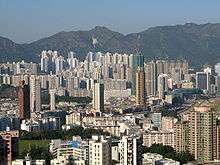Kowloon City
| Kowloon City | |||||||||||
 High-rise buildings have been built in Kowloon City after the relocation of the Hong Kong International Airport from Kowloon City to Chek Lap Kok. | |||||||||||
| Traditional Chinese | 九龍城 | ||||||||||
|---|---|---|---|---|---|---|---|---|---|---|---|
| Simplified Chinese | 九龙城 | ||||||||||
| |||||||||||

Kowloon City (九龍城; "Nine Dragon City") is an area in Kowloon, Hong Kong. It is named after the Kowloon Walled City, and is administratively part of Kowloon City District.
Compared with the administrative Kowloon City District, the Kowloon City area is vaguely bounded south by Prince Edward Road West and Prince Edward Road East, north with Lo Fu Ngam, east with Kai Tak Nullah and west with Kowloon Tsai.
History

As early as in the Qin Dynasty (221 BC-206 BCE), Kowloon City was famous for its pearl production. During the Song Dynasty (960-1279), Kowloon City was a part of Kwun Fu Cheung (官富場), which was a part of salt yard governed by Chinese officials.
Part of the district was the location of the original Kowloon Walled City, erected during the Qing Dynasty. This is now Kowloon Walled City Park. The former Kai Tak International Airport was also located in the district.
In 1982, Hong Kong was divided into 18 administrative districts, and Kowloon City and its neighbouring areas, such as Hung Hom, now belong to the Kowloon City District.
Prior to 1998, a strict building height restriction was imposed in Kowloon City to minimize the hazards of air traffic commuting through the Kai Tak Airport. The closure of Kai Tak as a result of the opening of the new Hong Kong International Airport lifted the height restriction, and high-rise apartments started to appear.
Sights
- Holy Trinity Cathedral, the oldest church in Kowloon City
- Kai Tak Airport, a defunct airport in Kowloon City
- Kowloon City Plaza
- Kowloon Walled City
- Sung Wong Toi Park
- Kowloon City’s public market - one of the largest markets in Hong Kong[1][2]
Features
Kowloon City is an old district in Hong Kong; however, it has been transforming into a modern district with a lot of new shops and restaurants over the years. The district is well known for its wide range of cuisine. Other than the traditional Hong Kong-style restaurants that offer local dishes, there are numerous restaurants that offer Southeast Asian dishes like Thai, Vietnamese and Indonesian. Many Thai grocery stores can be found throughout this place, too. Due to the prevalence of Thai restaurants and stores as well as the population of Thai-speaking ethnic Chinese, Kowloon City is also known as "Hong Kong's Little Thailand." [3] Kowloon City is not only a food paradise for authentic main dishes of many cultures, but also a popular place for both traditional Hong Kong-style and western desserts. There are many famous and highly rated bakeries and dessert shops, e.g., the Tony Wong Patisserie and Smile Yogurt & Dessert Bar. [4]
Transportation
Major roads that serves the area include:
Public transport
- 1, 1A, 2A, 2D, 3B, 3C, 5, 5C, 6c, 6D, 6F, 7B, 9, 10, 11B, 11D, 11X, 12A, 13D, 14, 15, 16, 17, 21, 24, 26, 27, 28, 40, 42, 61X, 75X, 85, 85A, 85B, 85C, 93K, 95, 98C, 203E, 296C, 297, N216, N293
- 796C, 796X, N796
- A22, E22, N23, N26
- Cross Harbour Tunnel
- 101, 106, 107, 111, 113, 115, 116, N121
- 2, 2A, 13, 25M, 33, 46, 69, 69A, 82M, 105, 105S, 110
See also
References
- < A history of Kowloon City > (九龍城風物志)
- ↑ DeWolf, Christopher (23 September 2011). "Best wet markets in Hong Kong". CNN Travel. Retrieved 2011-10-09.
- ↑ Goldberg, Lina (24 February 2013). "10 of the world's best fresh markets". CNN Travel. Retrieved 24 February 2013.
- ↑ "A walking tour of Hong Kong's Little Thailand". http://travel.cnn.com/hong-kong/play/little-thailand-hong-kong-842555. External link in
|website=(help); - ↑ "Why we love Kowloon City". http://travel.cnn.com/hong-kong/visit/day-kowloon-city-971734. External link in
|website=(help);
| Wikimedia Commons has media related to Kowloon City. |